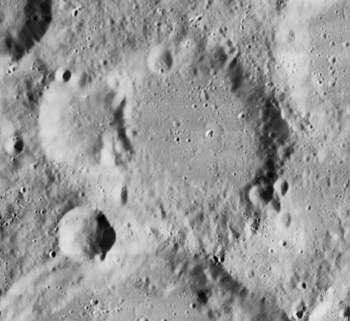Fernelius (crater)
 Lunar Orbiter 4 image | |
| Coordinates | 38°06′S 4°54′E / 38.1°S 4.9°ECoordinates: 38°06′S 4°54′E / 38.1°S 4.9°E |
|---|---|
| Diameter | 65 km |
| Depth | 1.8 km |
| Colongitude | 356° at sunrise |
| Eponym | Jean Fernel |
Fernelius is a lunar impact crater located in the southern highlands just to the north of the walled plain Stöfler. The crater Kaiser is located next to the northwest rim of Fernelius. To the north-northwest are the craters Nonius and Walther. Southeast of Fernelius is the crater cluster of Miller, Nasireddin, Huggins, and Orontius.
In the past the floor of Fernelius has been resurfaced, leaving a relatively flat, featureless surface with no central peaks. The crater rim has been heavily worn and indented by impacts, the most prominent being Fernelius A which intrudes into the western rim. Ray material from Tycho lies along the northwest rim and around it towards the northwest.
Names
The crater is named after Jean Fernel, it was given its name by Giovanni Riccioli, whose 1651 nomenclature system has become standardized.[1][2] Earlier lunar cartographers had given the feature different names. Johannes Hevelius in his 1647 map called it "Montes Fortis" after the "strong mountains" of the ancient world.[1][3]
In some publications, it is misidentified as "Furnelius" especially the 1979 NASA Lunar Chart (LPC-1).
Satellite craters

By convention these features are identified on lunar maps by placing the letter on the side of the crater midpoint that is closest to Fernelius.
| Fernelius | Latitude | Longitude | Diameter |
|---|---|---|---|
| A | 38.3° S | 3.5° E | 30 km |
| B | 37.4° S | 4.1° E | 10 km |
| C | 38.9° S | 4.4° E | 7 km |
| D | 38.2° S | 6.2° E | 7 km |
| E | 38.3° S | 6.6° E | 6 km |
References
- 1 2 Ewen A. Whitaker, Mapping and Naming the Moon (Cambridge University Press, 1999).
- ↑ Riccioli map of the Moon (1651)
- ↑ Hevelius map of the Moon (1647)
- Andersson, L. E.; Whitaker, E. A. (1982). NASA Catalogue of Lunar Nomenclature. NASA RP-1097.
- Blue, Jennifer (July 25, 2007). "Gazetteer of Planetary Nomenclature". USGS. Retrieved 2007-08-05.
- Bussey, B.; Spudis, P. (2004). The Clementine Atlas of the Moon. New York: Cambridge University Press. ISBN 978-0-521-81528-4.
- Cocks, Elijah E.; Cocks, Josiah C. (1995). Who's Who on the Moon: A Biographical Dictionary of Lunar Nomenclature. Tudor Publishers. ISBN 978-0-936389-27-1.
- McDowell, Jonathan (July 15, 2007). "Lunar Nomenclature". Jonathan's Space Report. Retrieved 2007-10-24.
- Menzel, D. H.; Minnaert, M.; Levin, B.; Dollfus, A.; Bell, B. (1971). "Report on Lunar Nomenclature by the Working Group of Commission 17 of the IAU". Space Science Reviews. 12 (2): 136–186. Bibcode:1971SSRv...12..136M. doi:10.1007/BF00171763.
- Moore, Patrick (2001). On the Moon. Sterling Publishing Co. ISBN 978-0-304-35469-6.
- Price, Fred W. (1988). The Moon Observer's Handbook. Cambridge University Press. ISBN 978-0-521-33500-3.
- Rükl, Antonín (1990). Atlas of the Moon. Kalmbach Books. ISBN 978-0-913135-17-4.
- Webb, Rev. T. W. (1962). Celestial Objects for Common Telescopes (6th revised ed.). Dover. ISBN 978-0-486-20917-3.
- Whitaker, Ewen A. (1999). Mapping and Naming the Moon. Cambridge University Press. ISBN 978-0-521-62248-6.
- Wlasuk, Peter T. (2000). Observing the Moon. Springer. ISBN 978-1-85233-193-1.
| Wikimedia Commons has media related to Fernelius (crater). |
